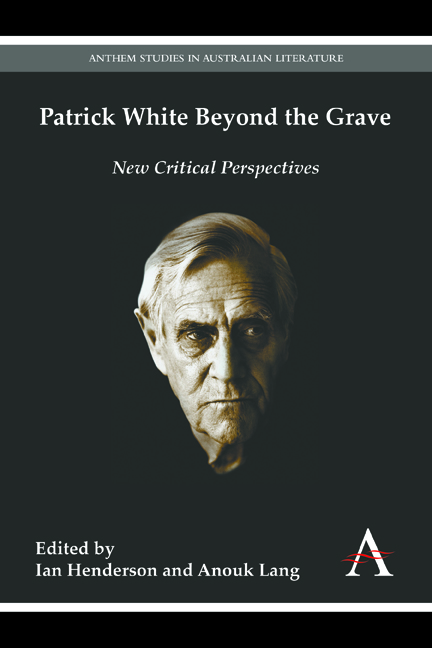Book contents
- Frontmatter
- Contents
- Acknowledgements
- Introduction
- Part I RESURRECTED PAPERS
- Part II MANY IN ONE
- Part III THE PERFORMANCE OF READING
- Chapter 7 Patrick White's Expressionism
- Chapter 8 The Doubling of Reality in Patrick White's The Aunt's Story and Paul Schreber's Memoirs of My Nervous Illness
- Chapter 9 Desperate, Marvellous Shuttling: White's Ambivalent Modernism
- Chapter 10 ‘Time and Its Fellow Conspirator Space’: Patrick White's A Fringe of Leaves
- Part IV QUEER WHITE
- Contributors
- Index
Chapter 10 - ‘Time and Its Fellow Conspirator Space’: Patrick White's A Fringe of Leaves
from Part III - THE PERFORMANCE OF READING
Published online by Cambridge University Press: 18 January 2018
- Frontmatter
- Contents
- Acknowledgements
- Introduction
- Part I RESURRECTED PAPERS
- Part II MANY IN ONE
- Part III THE PERFORMANCE OF READING
- Chapter 7 Patrick White's Expressionism
- Chapter 8 The Doubling of Reality in Patrick White's The Aunt's Story and Paul Schreber's Memoirs of My Nervous Illness
- Chapter 9 Desperate, Marvellous Shuttling: White's Ambivalent Modernism
- Chapter 10 ‘Time and Its Fellow Conspirator Space’: Patrick White's A Fringe of Leaves
- Part IV QUEER WHITE
- Contributors
- Index
Summary
If, as some say, timing is everything, the temporal rhythm of Patrick White's drafting of A Fringe of Leaves (1976) – in two bursts more than a decade apart (1961 and 1975) – must have had a bearing on its curiously doubled temporalities, its thickening and interleaving of past, present and future. Events in White's life at the time of drafting may also have contributed to the studied theatricality of its recurring settings, or chronotopes: of boat, shipwreck, island, church and forest clearing. Mikhail Bakhtin provides a painterly description of the literary-artistic chronotope:
… spatial and temporal indicators are fused into one carefully thought out, concrete whole. Time, as it were, thickens, takes on flesh, becomes artistically visible; likewise, space becomes charged and responsive to the movements of time, plot and history. This intersection of axes and fusion of indicators characterizes the artistic chronotope.
While this applies to any novel, it resonates with White's fictional vision in particular ways. In Riders in the Chariot (1961), for example, there is a telling description of Alf Dubbo's painting, ‘The Chariot Thing’ in which artistic illusion – standing for fictional fabrication – affords an unlikely access to truth. When viewed from an angle the painting fleetingly achieves an optical illusion, ‘a reversal of the relationship between permanence and motion’, in which the banks of the river seem to move, while the river lies still: ‘So he encouraged an illusion which was also a truth, and from which the timid might retreat simply by changing their position.’
While the irreversible flow of the river allegorizes phenomenal time, the painting's optical inversion – the solid riverbank flowing against the fixity of the river – allegorizes the literary-artistic project itself. Art suspends and thickens time, and liquefies place. All that is solid melts, and all that melts solidifies. There is a cryptic quality to White's chronotopic imagery. It promises without quite revealing truths. Or more precisely, it dwells on an infinite deferral between promise and revelation. A spatio-temporal reversal is effected by the optics of the image from the standpoint of the viewer. By implicating spectator and spectacle, White's vignette of Dubbo's painting also evokes the agonistic theatre of public appearing; it reverberates with self-consciousness about its own image production.
- Type
- Chapter
- Information
- Patrick White Beyond the GraveNew Critical Perspectives, pp. 163 - 178Publisher: Anthem PressPrint publication year: 2015



